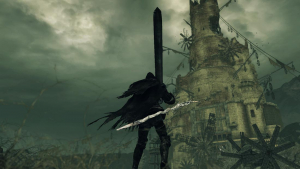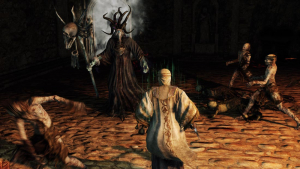Welcome to part 10 of a brand new mega list for CelJaded’s Top 100 Best Video Games. This tenth post features entry #10 – Dark Souls II.
Be sure to read the introduction that I put together beforehand too as it gives a more detailed introduction on what I’m trying to achieve here as well as a few other random musings that you may find insightful.
If you’re looking for another post in this same series then consider visiting the associated index which includes a readout of all published entries and the posts in which they appear.
“Perhaps you’ve seen it, maybe in a dream. A murky, forgotten land. A place where souls may mend your ailing mind.”
#10 – Dark Souls II
Principal Platforms: PlayStation 4, Xbox One, PC, PlayStation 3, Xbox 360 | Developer: From Software | Publisher: From Software, Namco | Genre: RPG | Year: 2014
You are of the undead. An auger of darkness and the Bearer of the Curse. An unfortunate lost soul branded with the Darksign; a curse that robs you of your rightful death and will one day ensure your bleak future as a mindless ‘hollow’ being.
The Darksign forces you to wander the land seeking souls; a source of raw energy that every living being covets and the fuel that will keep you from going hollow just a little bit longer for you to try and rid yourself of this curse.
The memories of your former life have all since melted away and it is now that an irresistible urge has drawn you to a mysterious land called Drangleic; a place that has long since been destroyed by the undead curse, but a place rife with many powerful souls for a warrior brave enough to claim them.
Dark Souls II may be set in a totally new environment with a (mostly) separate story, but anyone who has played the prequel will feel right at home during the opening sixty minutes of play.
The intuitive combat still has that weighty feel to it, enemies still aggressively attack in packs, and you’re given little guidance on where to go other than the subtle hint of “seek the king”. The graphics are similarly sharp, bosses are still a spectacle and there are many breathtaking views to see throughout the land of Drangleic. If nothing else, this is a sequel that offers more of the same quality “stuff” as before.
Dark Souls II makes many changes for the better though and it’s my opinion that these subtle refinements don’t get quite as much praise as perhaps they should.
The balancing of weapons is the first big change and compared to the first game, every play style feels viable for reaching the end. Pyromancy damage now scales with your attribute points, dual wielding has its own dedicated mechanic, and the parrying system requires faster reflexes in exchange for a greater advantage.
Although the lighting system isn’t as robust as seen in the beta footage, the game world still looks gorgeous when lit up by a hand-held torch and the added graphical polish for the PC version is a big improvement over the prior effort for the format. It has to be said that online connectivity (whilst still far from perfect) is a big improvement and it’s easier to get together with other players for PvP and cooperative boss battles than it was in Dark Souls.
Dark Souls II is a massive game. Compared to the original, this sequel is truly huge and features many additional areas, characters, and gameplay hours than ever before. The atmosphere is unmistakable, the gameplay is rich, and it all makes for an incredible first time experience.
To reiterate a little of what I said in the last entry; the Dark Souls games are very difficult, they don’t tutor the player on key mechanics and even the lowliest of enemies can quickly tear your health bar to shreds if you’re not prepared.
If you’re at all familiar with Dark Souls then it’s likely that these comments will seem familiar to you. Unlike many modern video games, the Dark Souls series is unique in that many people all share the exact same sentiments about its design.
The difficulty is harsh but fair, the choices you make have weight, and the learning curve is extremely satisfying in its own right. Another common sentiment comes in the form of its enjoyment factor alone; a phenomenon whereby players (myself included at one point) find it difficult to enjoy other games after playing Dark Souls for an extended period of time. Clearly the veterans at From Software are onto something here and the results just speak for themselves.
Another area in which this sequel matches its forerunner is in the story. Just like every other facet of the game, the story here is something you have to work at. Knowing is half the battle after all and Dark Souls II doesn’t give anything away for free.
Very similar to The Sopranos of all things, the Dark Souls games let the player make up their own mind on many aspects of the story. As a viewer you’re respected enough to think for yourself; to ruminate on character motivations and it’s a rare occurrence that you’re given facts at their face value. Item descriptions beg many questions about the events that transpired in Drangleic and as a player you’re expected to offer your own interpretation on what’s happening behind the scenes.
Dark Souls II itself though, despite being critically acclaimed, is often criticized in ways that I don’t think are entirely reasonable. It’s described as a much easier game for one; something that, in the strictest sense at least, really isn’t true. If a player finds this sequel easier, then it’s purely because of that player’s existing experience from Dark Souls (or even Demon’s Souls) being a factor.
In a landscape where some modern games can be beaten on their hardest setting in a couple of days, Dark Souls has changed things drastically. It’s not because the game is ultra difficult, it’s because the game is ultimately very fair.
This a game that anyone can get good at because it’s not all about precise timing and learning input commands; it’s about learning the game’s delicate rhythm of attack and counter attack, of effective stamina management, and remaining calm whilst under intense pressure. It seems crazy at first, but these are things that anyone can do when presented with such fluid controls and intuitive gameplay.
This sequel is still a ruthlessly tough game throughout, but the aptitude and experience gained from playing the first game will translate over very well. For instance, dodging should be second nature, conserving health items a given, and the expectation of possible dangers that may lurk around the next corner are all things that a veteran player is going to have working in their favour here.
It’s not fair to judge Dark Souls II as being overly easy when considering both this and the fact that an in-game feature exists to specifically make the game harder by enhancing enemies and restricting cooperative multiplayer to willing players.
Bizarrely enough, this criticism also extends into areas that are actually to the player’s benefit and the game’s merit. The more linear level design, easier sub-bosses, and reasonable travelling times between bonfire safe havens are often unfairly slammed as a diluent to the gameplay formula.
I see this as all part of a certain frustration that some players are feeling with regards to this sequel. These players are chasing after that initial feeling they had with the franchise; a heady feeling of vulnerability, of helplessness in the face of seemingly insurmountable odds and the notion that the game is testing them in some way. It’s true that this game and its prequel may have been higher on this list if I felt that the “second time through” was as good as the first (sadly I don’t feel that way), but even still, it’s not something I hold against Dark Souls II as a complete experience.
The fantastic Lost Crowns trilogy of downloadable content does very well in answering some of the core game’s criticisms though. These self-contained adventures have intuitive signposting, a good level of difficulty, and plenty of new bosses to butt heads with.
The music in Dark Souls II is still as stirring and thematic as the first game, only this time there are fewer repeated tracks and almost every major boss battle receives its own dedicated theme.
Usually a very quiet and foreboding game (the audio designer rightly assumed that persistent background music would make it hard to concentrate!), Dark Souls II comes rivetingly alive during its boss encounters. It’s just a shame that the default music level is set so low! New players take my advice and increase the music volume to maximum!
Dark Souls II does have its missteps, no doubt about it. The lighting mechanic that has been clearly scaled back from the original design is woefully underused as only one area in the game really requires you to pack a torch. Also disappointing is the new degenerating health bar system which is a big design mistake as it clips a player’s desire to experiment and will necessitate mindless farming of items if taken too far.
Certain bosses are a bit anti-climatic, the lifegem items make healing far too easy, and the order in which endgame locations must be visited is an overly fussy affair that really should have been better streamlined.

In the Scholar of the First Sin edition, the Pursuer frequently reappears to ambush players in other areas across Drangleic. Clearly being dead is no excuse for slacking off.
To a certain extent I feel that the perfect Dark Souls game hasn’t been made yet. What we have now is miles ahead of most other RPGs in terms of enjoyment (they’re #10 and #11 here after all), but there’s still room for improvement and that’s a very exciting prospect when you really think about it.




Leave A Comment